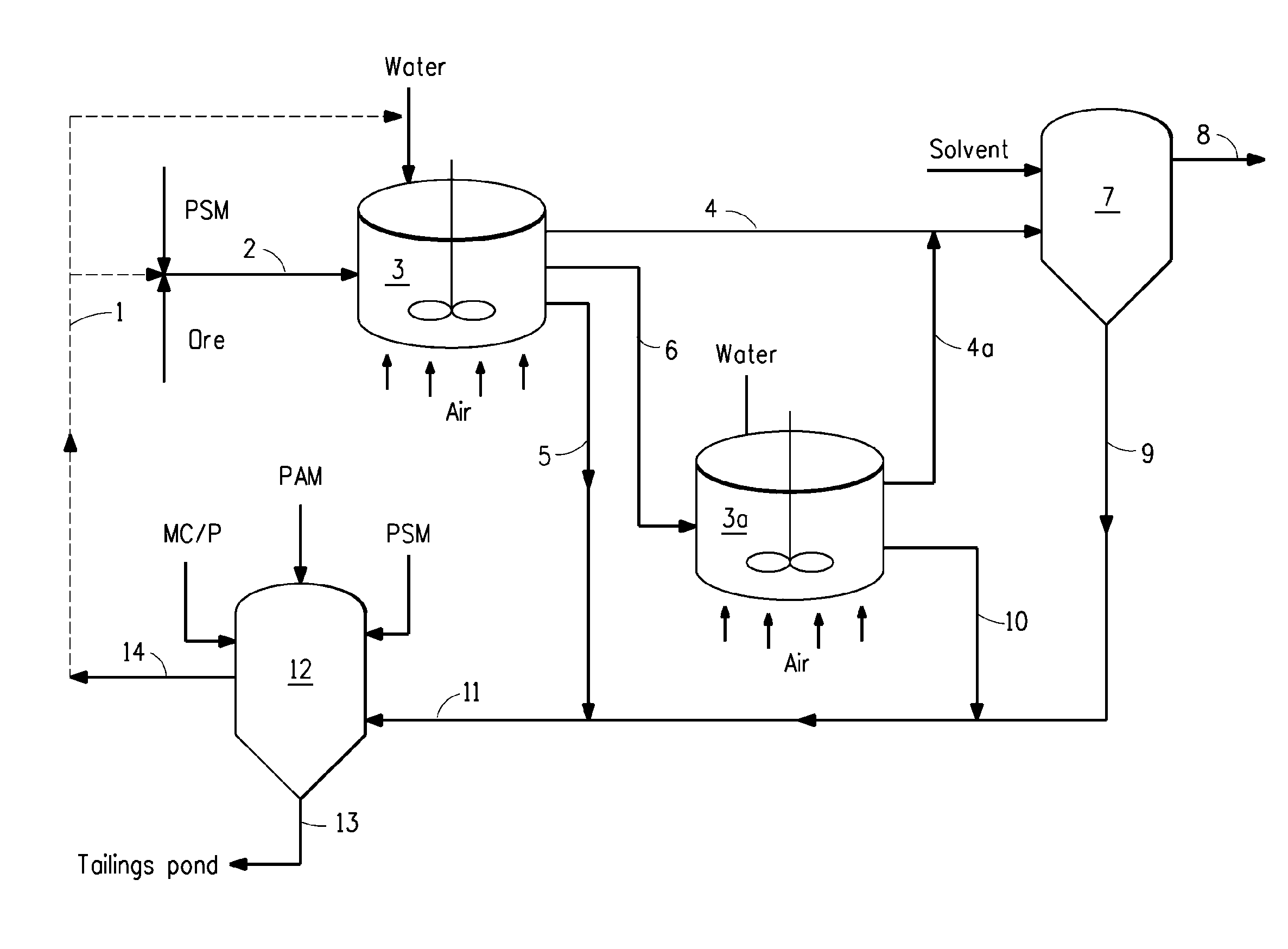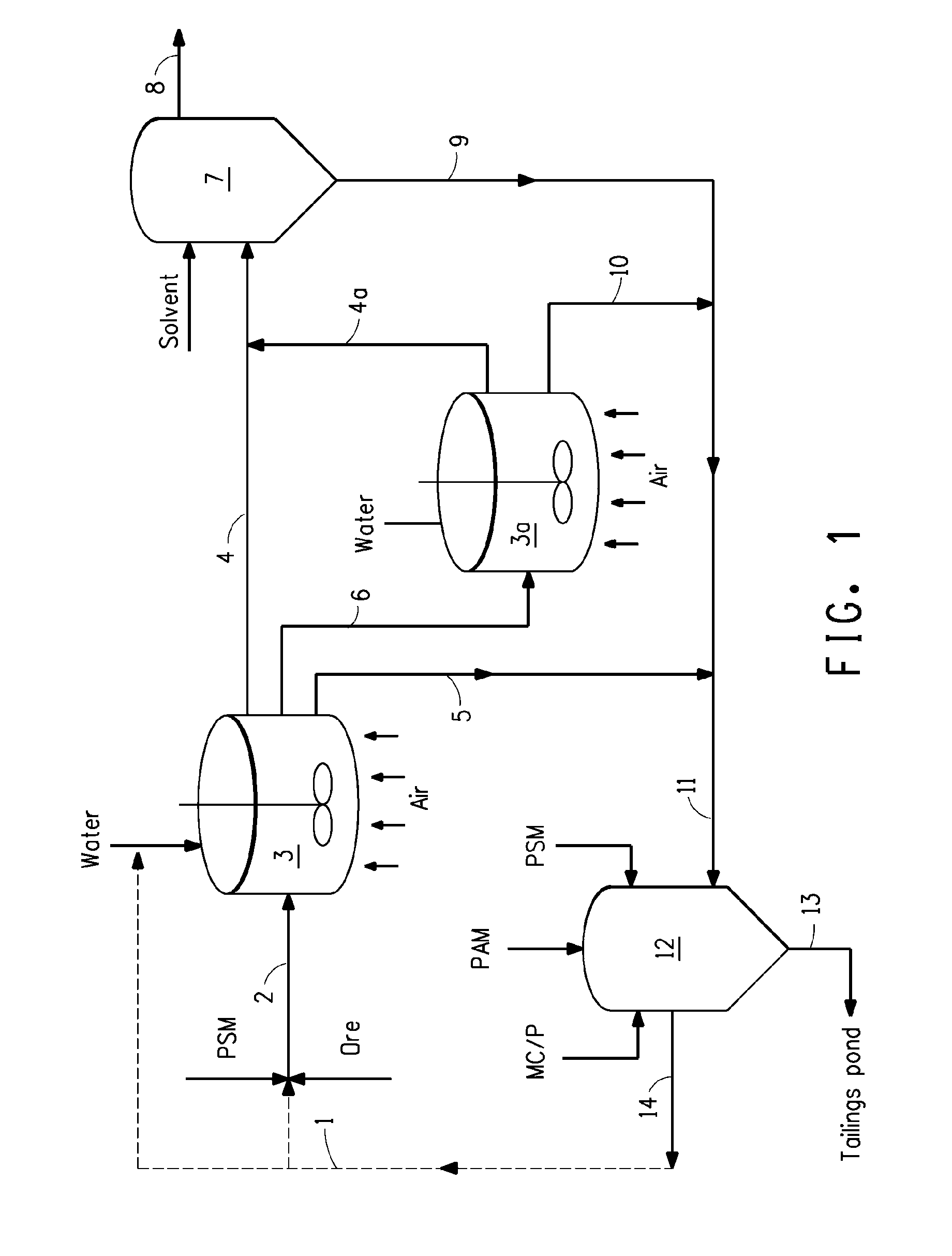Process for flocculation of a tailings stream
a technology of flocculation and tailings, which is applied in the direction of solid waste management, sustainable waste treatment, and separation processes, can solve the problems of toxic to animal life, solid waste dispersion, and lack of vegetative potential, so as to improve the recovery of bitumen, enhance flocculation, and not adversely affect the flocculation of tailings
- Summary
- Abstract
- Description
- Claims
- Application Information
AI Technical Summary
Benefits of technology
Problems solved by technology
Method used
Image
Examples
example 1
[0067]A clay fines slurry (2.5 g, 6.7% solids) retained from oil sands solvent recovery unit was added to a beaker. A 100 ppm (mg calcium per kg solution) as calcium sulfate solution (87.7 mL, 2.42 g CaSO4 in 2.5 L water) was prepared and added to the beaker. Water (87.7 g) was also added to bring the clay solids concentration to 2% and the slurry was stirred. An aqueous 0.1% solution of SUPERFLOC 135 (3.75 mL, 0.1%, an anionic polyacrylamide commercially available from Cytec Industries, West Paterson, N.J.) was added to the slurry and the slurry was stirred. After 30 seconds, aqueous polysilicate microgel solution (2.5 mL, 1% SiO2, commercially available from E. I. du Pont de Nemours and Company, Wilmington, Del.) was added to the slurry and the slurry was then stirred. After an additional 30 seconds, the stirring was stopped, and the beaker contents were filtered. The volume of the liquid passing through the filter paper was recorded and a solids concentration was calculated as de...
example 2
[0071]A clay fines slurry (2.5 g, 12.4% solids) retained from oil sands solvent recovery unit was added to a beaker. Water was added to the beaker to bring the clay solids concentration in the slurry to 2% by weight and the slurry was stirred. Aqueous polysilicate microgel solution (2.5 mL, 1% SiO2) was added to the slurry in the beaker and the slurry was stirred. A 35% aluminum hydroxide sulfate solution (0.524 mL, 7.16% Al2O3, commercially available under the brand name PASS 100, from Cleartech Industries, Inc., Saskatoon, SK, Canada) was added to the slurry and the slurry was stirred. Sodium hydroxide (6.1 mL, 0.3 N) was then added to the slurry to raise the pH to 8.4. An aqueous 0.1% solution of SUPERFLOC 135 (3.75 mL) was added to the slurry and the slurry was stirred. After 15 seconds, the stirring was stopped, and the beaker contents were filtered. The volume of the liquid passing through the filter paper was recorded and a solids concentration was calculated as described abo...
example 3
[0074]A clay fines slurry (2.5 g, 12.4% solids) retained from oil sands solvent recovery unit was added to a beaker. Water was added to the beaker to bring the clay solids concentration in the slurry to 2% by weight and the slurry was stirred. Aqueous polysilicate microgel solution (2.5 mL, 1% SiO2) was added to the slurry and the slurry was stirred. Sodium hydroxide (0.3 mL, 0.3 N) was then added to the slurry to raise the pH to 8.4. An aqueous 0.1% SUPERFLOC 135 solution (1.25 mL) was added to the slurry and the slurry was stirred. A 35% aluminum hydroxide sulfate solution (0.035 mL, 7.16% Al2O3) was added to the slurry and the slurry was stirred. After 30 seconds, an aqueous 0.1% PERCOL 7651 solution (0.5 mL, a cationic polyacrylamide commercially available from Ciba Specialty Chemical Corp., Tarrytown, N.Y.) was added to the slurry and the slurry was stirred. After 15 seconds, the stirring was stopped, and the beaker contents were filtered. The volume of the liquid passing throu...
PUM
| Property | Measurement | Unit |
|---|---|---|
| size | aaaaa | aaaaa |
| temperatures | aaaaa | aaaaa |
| wt % | aaaaa | aaaaa |
Abstract
Description
Claims
Application Information
 Login to View More
Login to View More - R&D
- Intellectual Property
- Life Sciences
- Materials
- Tech Scout
- Unparalleled Data Quality
- Higher Quality Content
- 60% Fewer Hallucinations
Browse by: Latest US Patents, China's latest patents, Technical Efficacy Thesaurus, Application Domain, Technology Topic, Popular Technical Reports.
© 2025 PatSnap. All rights reserved.Legal|Privacy policy|Modern Slavery Act Transparency Statement|Sitemap|About US| Contact US: help@patsnap.com


